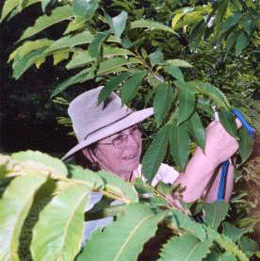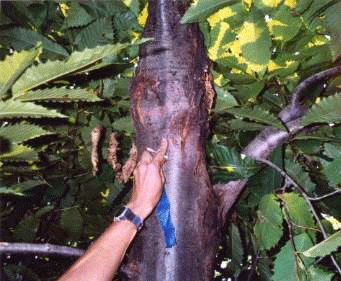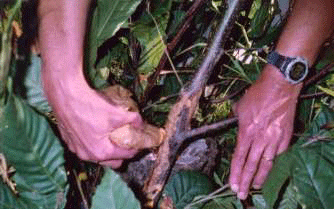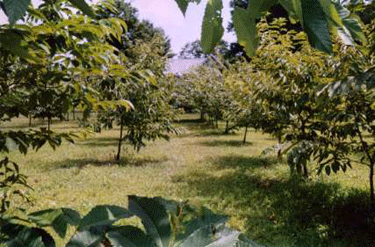Return of the King
Air Date: Week of October 14, 2005

The American Chestnut tree once covered more than a quarter of the eastern woodlands from Michigan to Maine, and down into Georgia. But more than a century ago, a lethal fungus began killing off the great trees. Three and a half billion trees died. But they may be coming back. Diane Toomey reports.
Transcript
CURWOOD: It was called the “King of Trees,” “The Redwood of the East.” The American chestnut tree once covered more than a quarter of the eastern woodlands from Michigan to Maine, and down into Georgia. Growing up to 100 feet tall with trunks as wide as five feet, American chestnuts were a critical food source for wildlife, and one of the best sources of lumber
Then, disaster struck. More than a century ago, a lethal fungus began to lay these great trees low. And it took only a few decades to kill an estimated three and a half billion trees. But a Connecticut researcher has been working for close to three decades to bring them back, and may be on the verge of success. Producer Diane Toomey reports.
ANAGNOSTAKIS: An orchard of American chestnut trees.

Dr. Anagnostakis in her experimental orchard near New Haven, Connecticut. (Photo: Diane Toomey)
And, like everywhere chestnut trees are found, chestnut blight is here in full force. Some of these trees look like no more than small shrubs. Dr. Sandy, a woman quick of smile and sensible of shoe, walks over to one infected little tree to offer a word of sympathy.
ANAGNOSTAKIS: Poor thing. This is a chestnut blight canker. You can see the orange on the bark. And the fungus has broken through the bark here to make these little orange spots. That’s where the spores are formed. And those spores will be carried by insects and animals to a wound on another chestnut stem and start another disease.

Chestnut Blight cankers. (Photo: Diane Toomey)
TOOMEY: Cankers, areas of sunken-in bark, are the telltale sign of chestnut blight infection. The fungus made its way into the U.S. in the late 1800s, hitching a ride on imported Asian chestnut trees. They’re much smaller than their American counterparts, but are naturally resistant to the blight. Even though the tale of the American chestnut is a tragedy, things could have been much worse. While the blight kills a tree’s branches and trunk, its root system usually survives.
ANAGNOSTAKIS: I keep telling people that no, chestnuts are not extinct, and they are not all gone. There just much shorter than they used to be (laughing)!
TOOMEY: That’s because an infected tree can, as least for a while, form new sprouts from its base. But like Sysiphus pushing his rock uphill, each time these stumps start to sprout again, they become infected and die back and then the process begins all over again. However, here in this orchard, something unusual is going on and Dr. Sandy’s trained eye easily spots it.
ANAGNOSTAKIS: Okay. Here’s a canker. Now this is a canker that started, probably, at a broken branch. The fungus got into bark and started distorting the bark, as you can see. But the tree is fighting back by producing callus and this is all swollen up.
TOOMEY: And that’s a good thing, because that swelling is a sign the tree is successfully fighting off the blight. That’s not because this tree is particularly strong, but because this blight is particularly weak, made so by a virus.
ANAGNOSTAKIS: It’s the old, big fleas have little fleas upon their backs to bite them, and little fleas have lesser fleas, and so ad infinitum.
TOOMEY: Dr. Sandy was part of the team that discovered that lesser flea. In the 1970s, she worked with a French researcher who noticed that many European chestnut trees were surviving bouts with the blight. It turned out the fungus had been disabled by a viral parasite which Dr. Sandy helped to identify. It still isn’t clear how the virus cripples the blight, but the fact that it does was reason enough for Dr. Sandy to try to get it into blight here in the U.S.
[SQUISHING SOUND: BIRDS CHIRPING]
SLUTTON: Okay, here comes the slurry. Just squish it into the hole! This is like a pastry bag or decorating a cake, frosting coming out.
ANAGNOSTAKIS: Yes! Experience in cake decorating would be helpful here!

Applying hypo-virulent fungus. (Photo: Diane Toomey)
TOOMEY: Pamela Slutton, Dr. Sandy’s assistant, bends toward the trunk of a chestnut tree, holds a plastic bag with a hole at the bottom, and squeezes out…well, let her tell you.
SLUTTON: This is a sandwich-sized zip lock bag containing a gelatinous mass of tawny flecked goo!
TOOMEY: That goo is actually blight fungus, grown and infected with the disabling virus in the lab. Any killer blight it comes into contact with will also come down with the virus. The plan today is to infect all the killer blight here in this experimental orchard.
Dr. Sandy is the only U.S. researcher working extensively with weakened chestnut blight, also known as hypovirulent blight. And it seems to be paying off. Pam points to the results of last year’s work, an area on a tree surrounded by old treatment holes.
SLUTTON: And now, the canker is swollen because the tree has calloused underneath there, healed around the canker. The hypovirulence did its job and stopped the virulent fungus from spreading. And the tree was able to catch up and get ahead of it! So knotty as they may be looking, that is a beautiful sight.
TOOMEY: Still, this approach alone won’t bring back the giants of the eastern forests, those 100-foot tall chestnut trees of yore. That’s because the trees must expend a great deal of energy to fight off even the weakened blight, so they stay small. But they do live to flower and produce nuts every year. So the wealth of that native genetic diversity can be preserved and put to use.
[FOOTSTEPS; CRUNCHING LEAVES ]

Experimental chestnut orchard in Windsor, Connecticut. Therese trees are farthest along in Dr. Anagnostakis’ breeding program. (Photo: Diane Toomey)
ANAGNOSTAKIS: That tree is a hybrid between a pure American and a pure Japanese.
TOOMEY: Not far from where Pam is spreading fungus goop, Dr. Sandy stands next to a small tree of mixed ancestry. It’s part of a time-consuming crossbreeding program. The goal? Trees that will grow as straight and tall as a pure American.
ANAGNOSTAKIS: And you can see it has fairly good timber form. It’s nice and straight.
TOOMEY: But with the blight resistance of the Asian species.
ANAGNOSTAKIS: There are very few cankers and the cankers that are present are not doing as much damage to the bark of the tree. So there is virus there, but even so, it looks a lot better than the Americans. So, even 50 percent Japanese allows the tree to have a fair amount of resistance.
TOOMEY: But that’s not good enough. To achieve complete resistance, two copies of all three genes that control for it must make their way from an Asian chestnut into a tree that will grow like an American. It takes a number of crossbreeding steps, using the trees kept alive with weakened blight to do that. Blight resistance can’t really be tested in these hybrids until they’re about five years old. So it’s been one long experiment for Dr. Sandy. But in another orchard, an hour’s drive away in Windsor, Connecticut, she believes she’s on the verge of success.
ANAGNOSTAKIS: I really like the way these look. It pleases me to see all of these nice timber trees.
[PASSING CAR, FOOTSTEPS]
TOOMEY: As cars drive by this experimental plot on the edge of forested land, Dr. Sandy walks through the seven neat rows of chestnut trees here. These are the ones farthest along in her breeding program, about 150 in all. Most of these six-year old hybrids are a healthy ten to 15 feet tall, and blight-free. It has taken a long time to get to this breakthrough, but over the past 27 years, Dr. Sandy has learned to operate on chestnut time.
ANAGNOSTAKIS: You have to be really patient. You have to live a long time and you can never retire.
TOOMEY: There’s a Chinese proverb that says a nation grows great when its old men plant trees whose shade they will never know. At 66, Sandy Anagnostakis won’t experience the shade of a 100-ft tall American chestnut tree, but she hopes to leave that legacy to future generations. For Living on Earth, I’m Diane Toomey Diane Toomey in Windsor, Connecticut.
Links
"Chestnuts and the Introduction of Chestnut Blight" by Dr. Sandra Anagnostakis
Living on Earth wants to hear from you!
Living on Earth
62 Calef Highway, Suite 212
Lee, NH 03861
Telephone: 617-287-4121
E-mail: comments@loe.org
Newsletter [Click here]
Donate to Living on Earth!
Living on Earth is an independent media program and relies entirely on contributions from listeners and institutions supporting public service. Please donate now to preserve an independent environmental voice.
NewsletterLiving on Earth offers a weekly delivery of the show's rundown to your mailbox. Sign up for our newsletter today!
 Sailors For The Sea: Be the change you want to sea.
Sailors For The Sea: Be the change you want to sea.
 The Grantham Foundation for the Protection of the Environment: Committed to protecting and improving the health of the global environment.
The Grantham Foundation for the Protection of the Environment: Committed to protecting and improving the health of the global environment.
 Contribute to Living on Earth and receive, as our gift to you, an archival print of one of Mark Seth Lender's extraordinary wildlife photographs. Follow the link to see Mark's current collection of photographs.
Contribute to Living on Earth and receive, as our gift to you, an archival print of one of Mark Seth Lender's extraordinary wildlife photographs. Follow the link to see Mark's current collection of photographs.
 Buy a signed copy of Mark Seth Lender's book Smeagull the Seagull & support Living on Earth
Buy a signed copy of Mark Seth Lender's book Smeagull the Seagull & support Living on Earth

